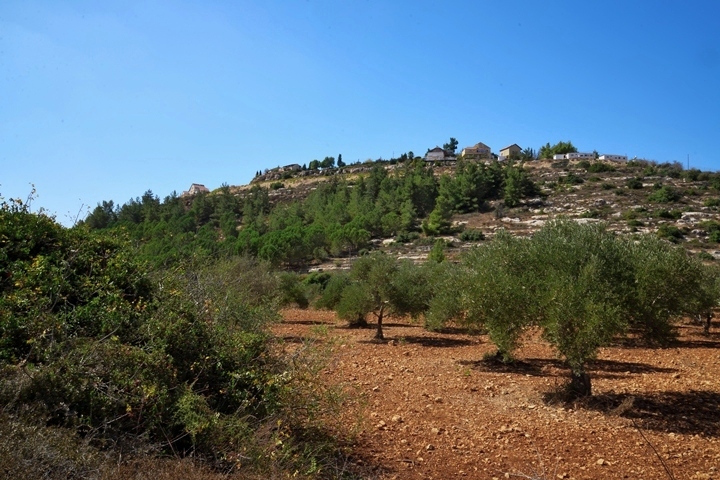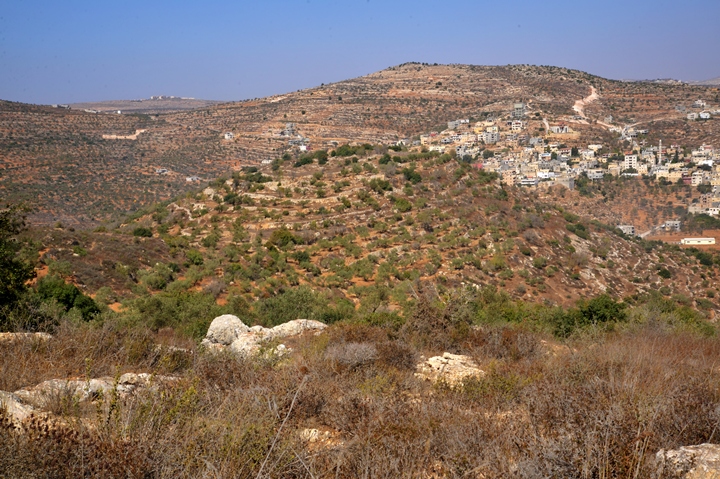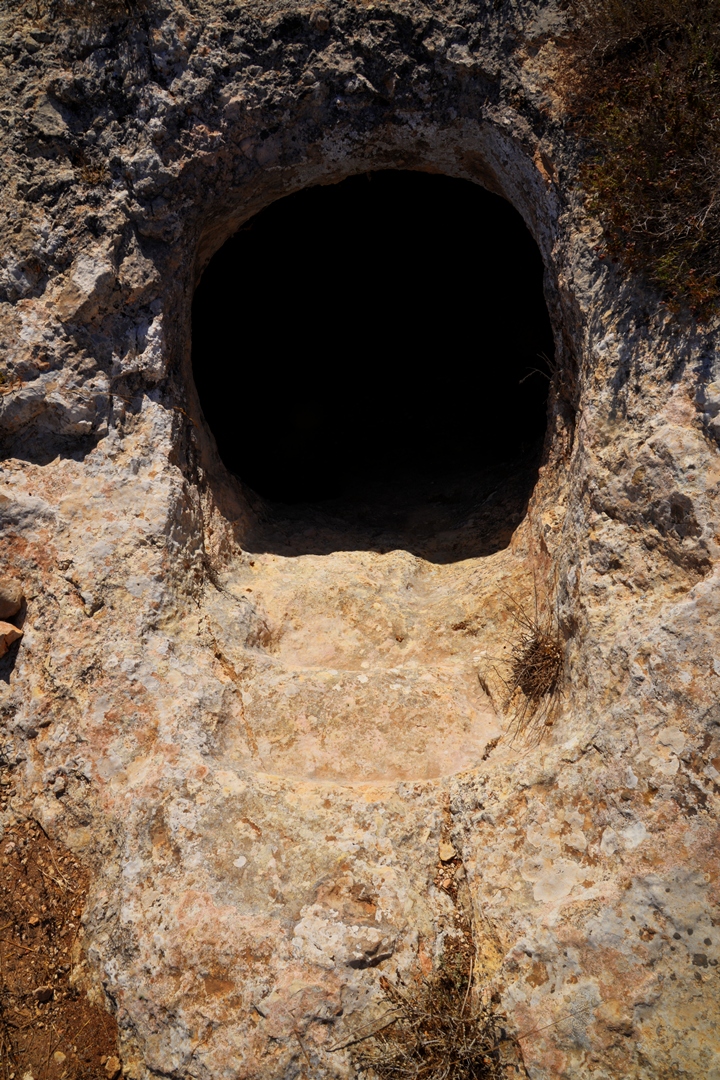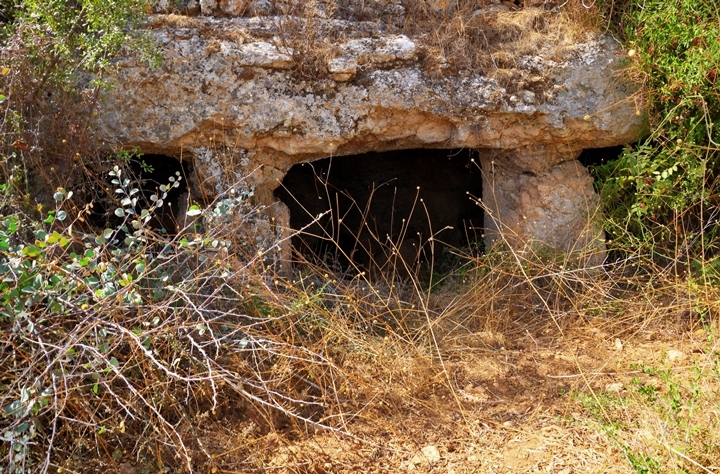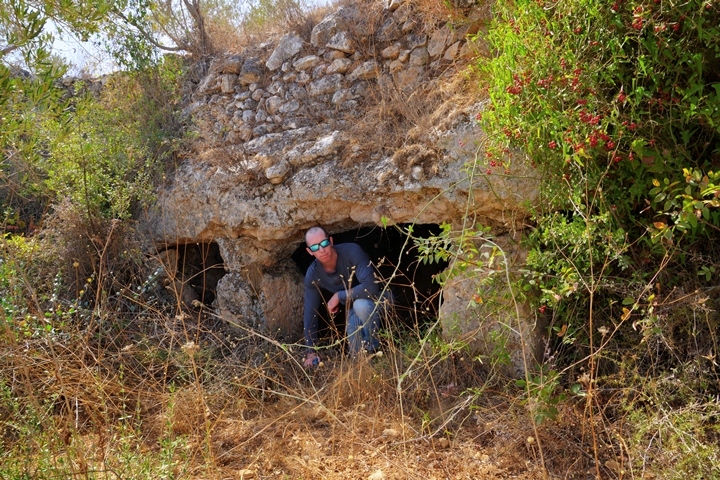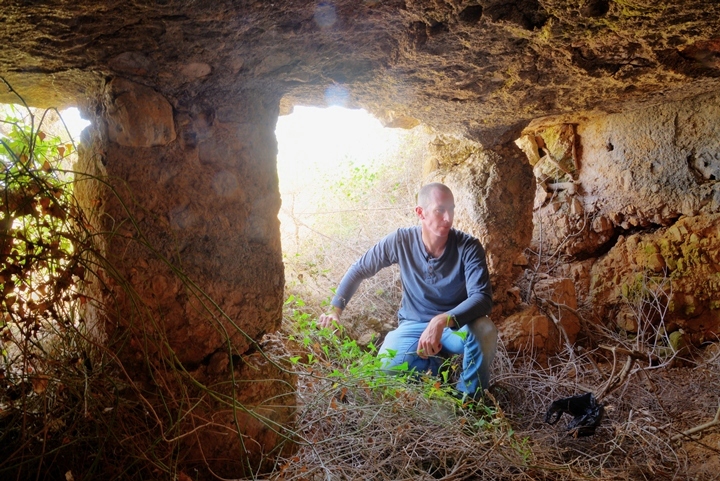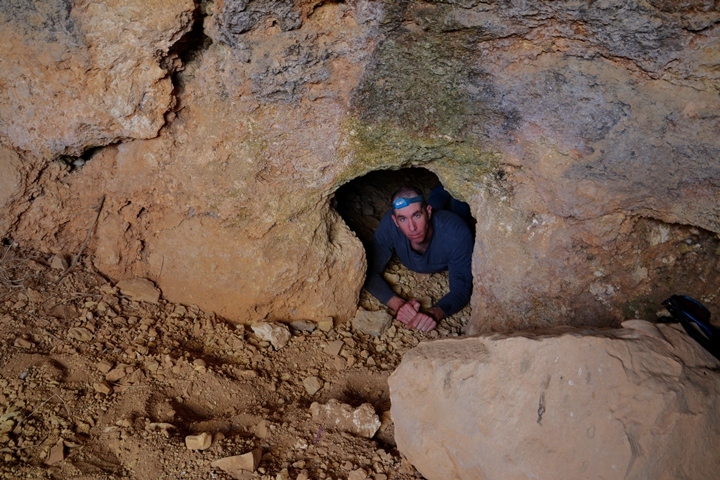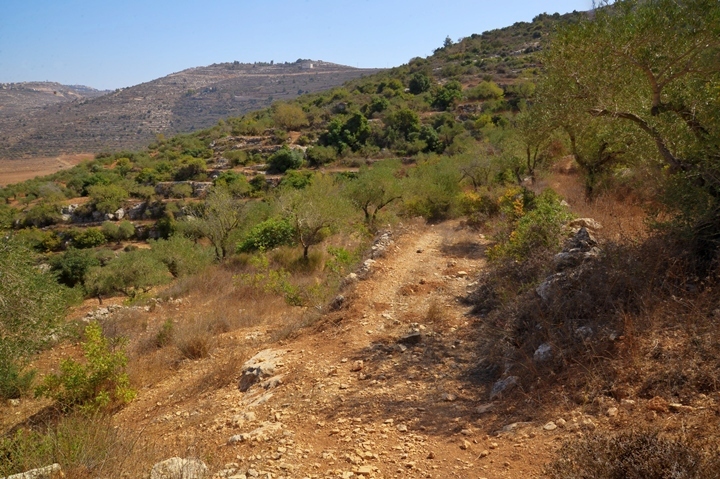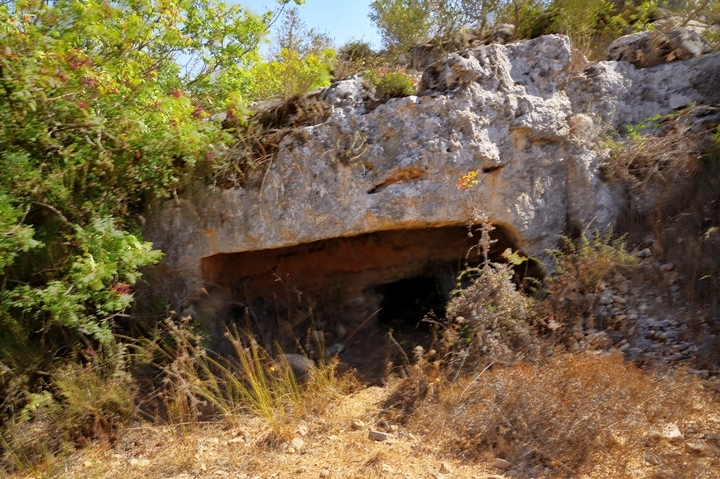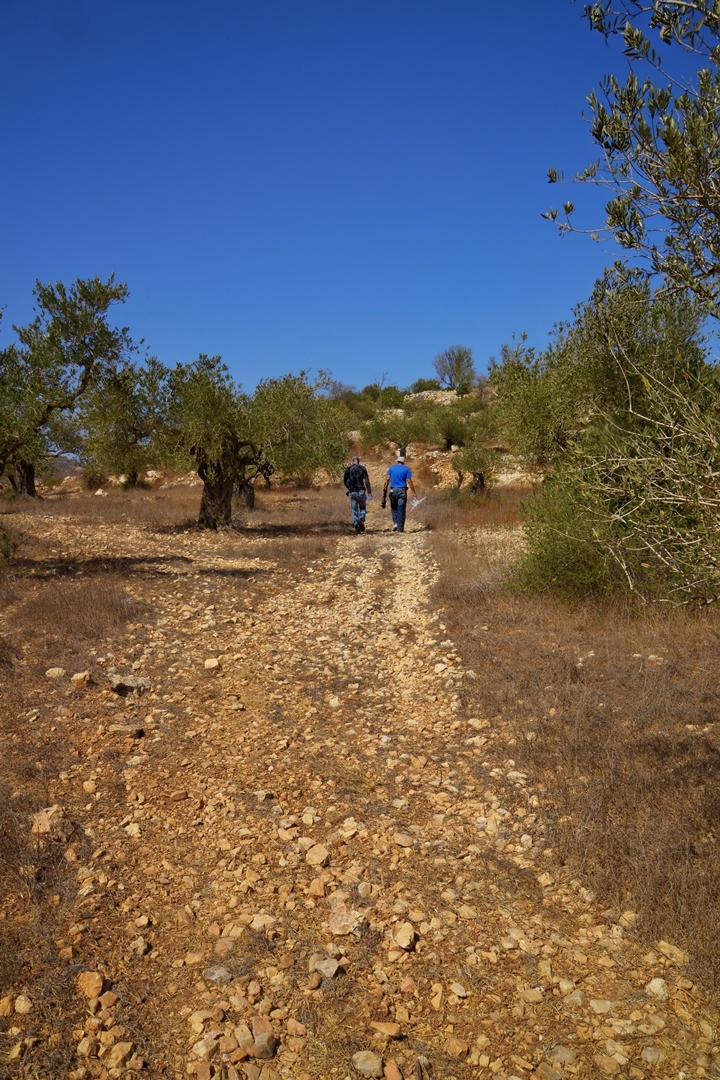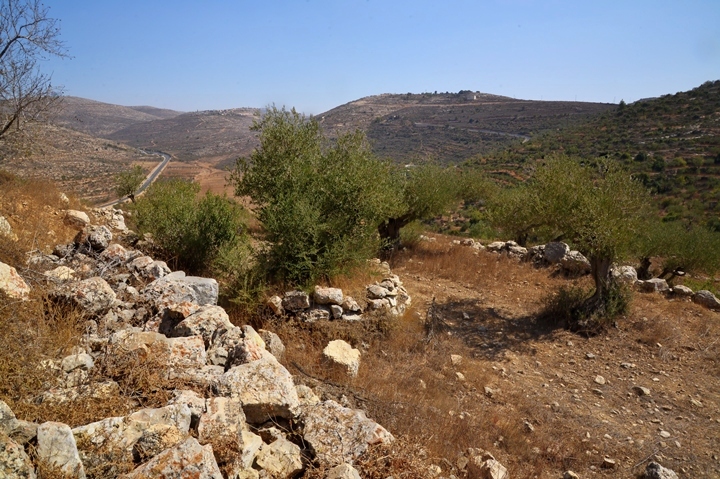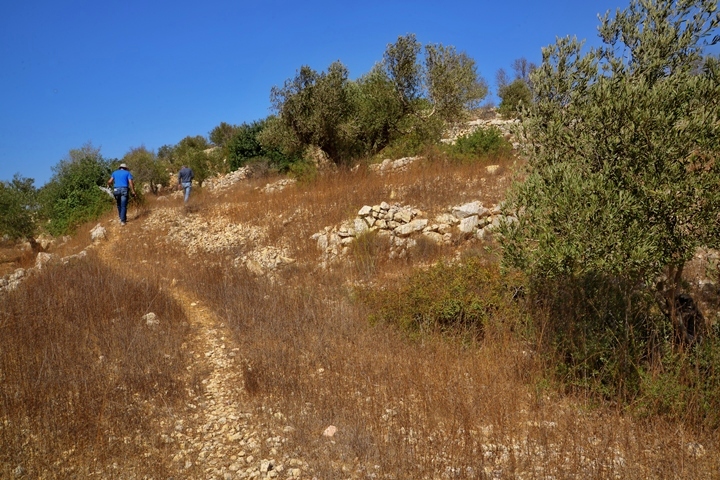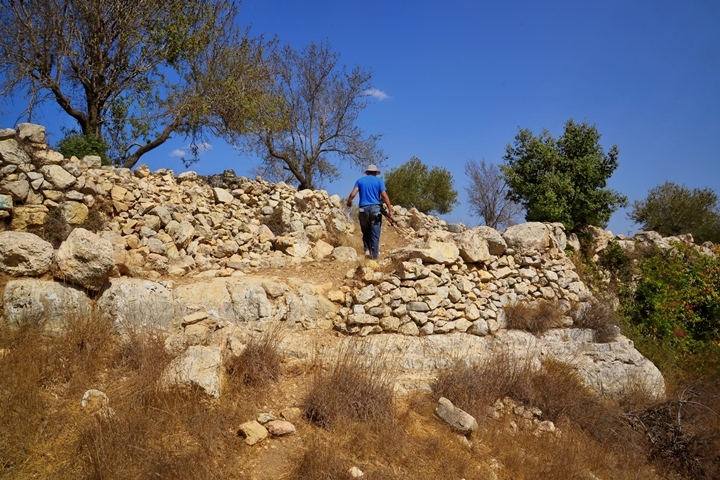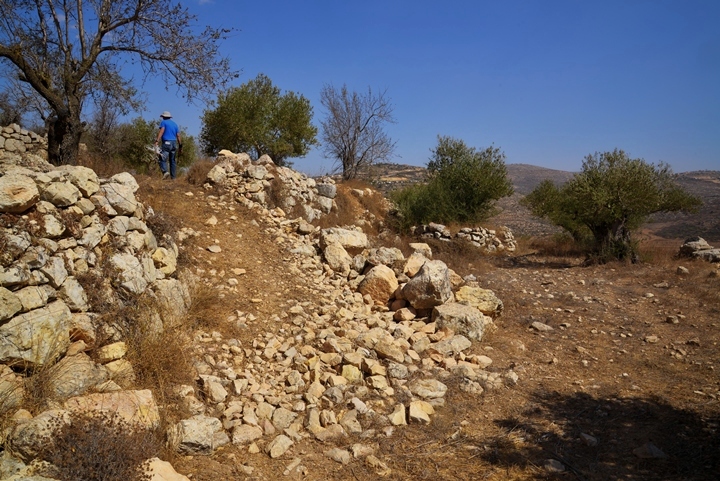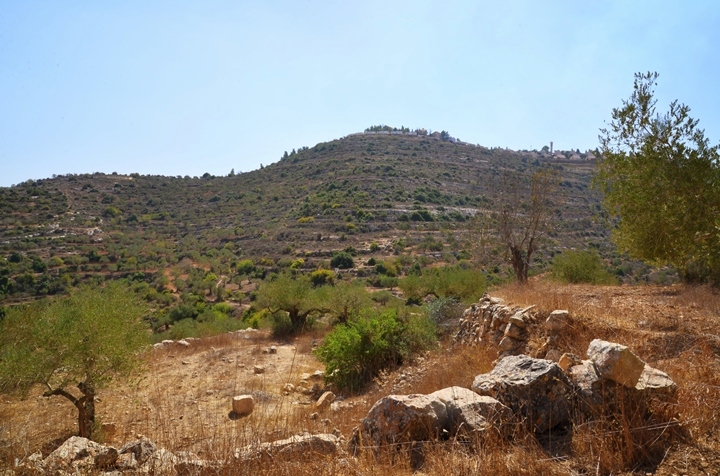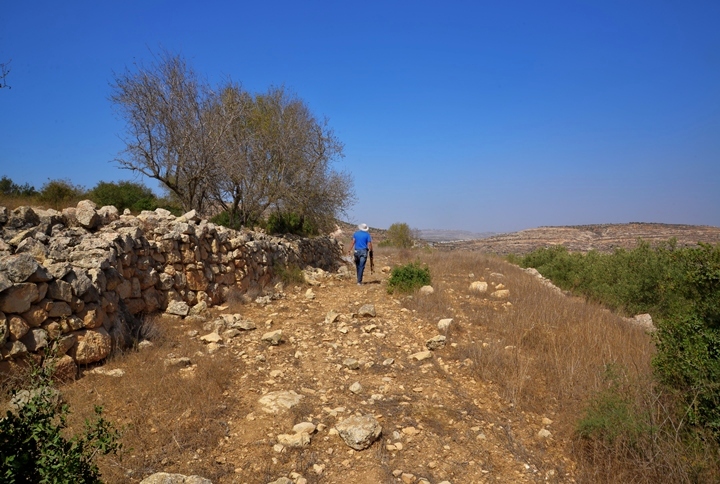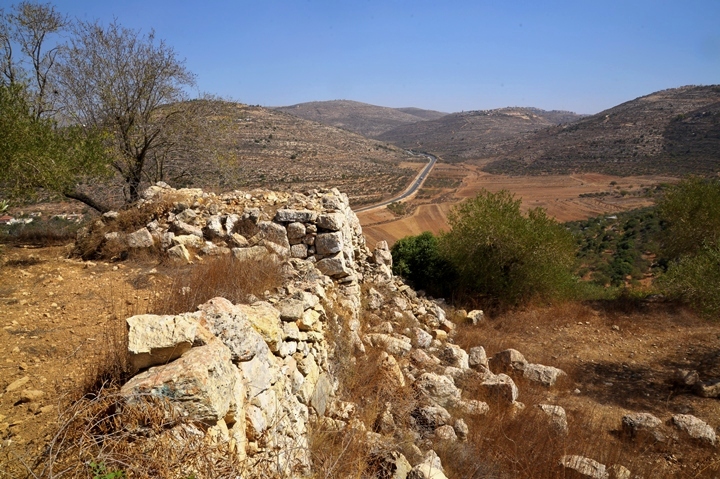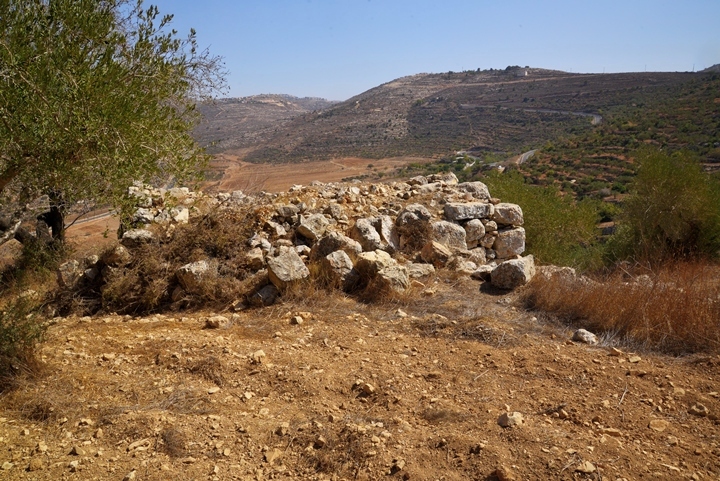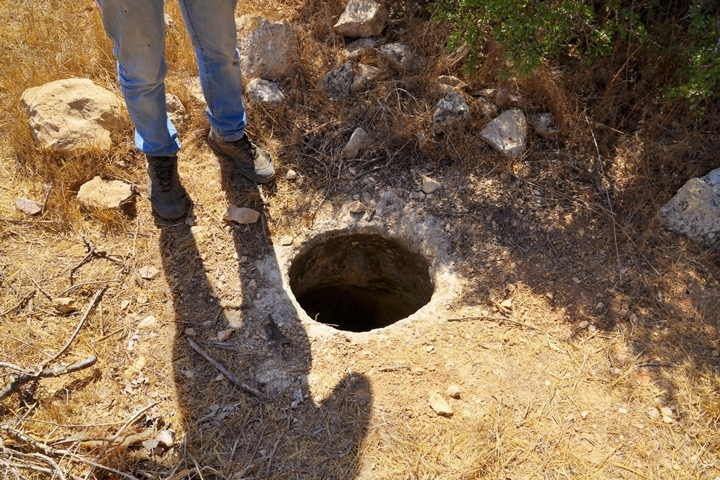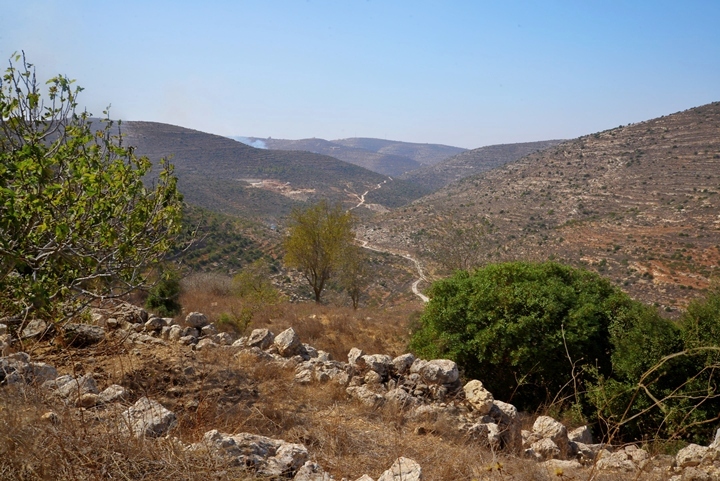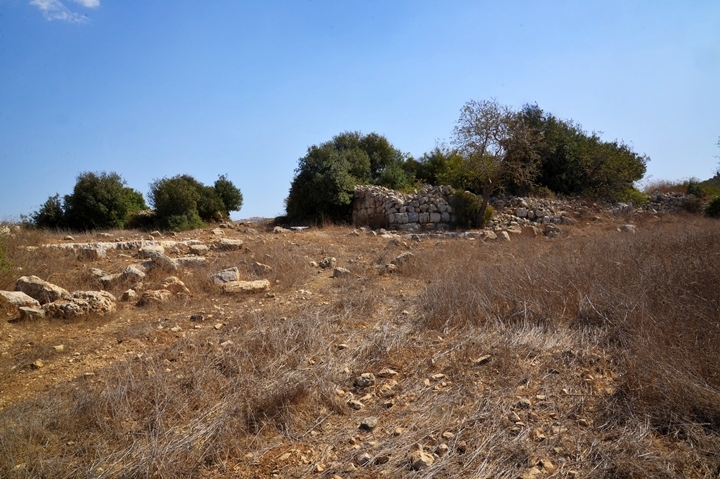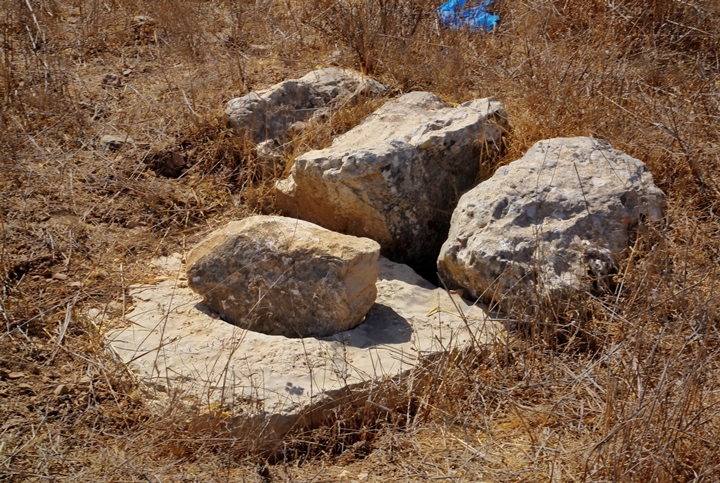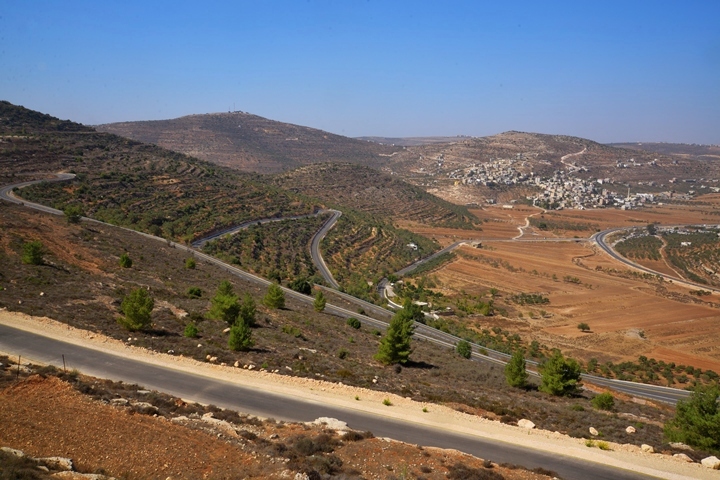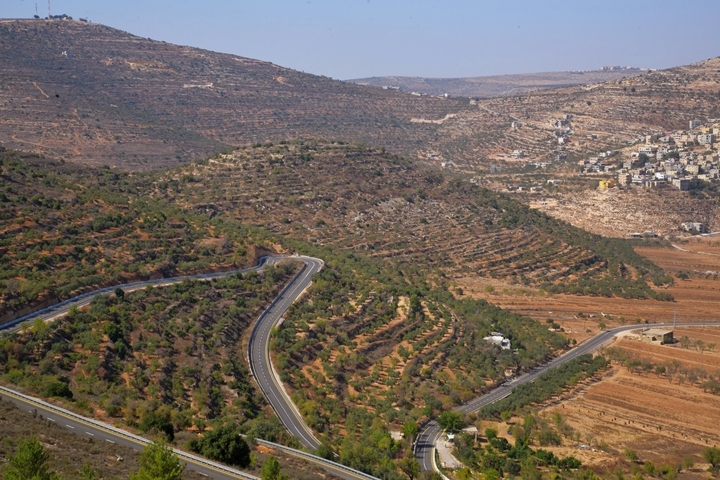Ruins of a fortified village situated near the Lebonah ascent. Identified as Kfar Lakitia – one of the Roman garrisons at the end of the Bar- Kokhba revolt.
* Site of the month Sep 2017 *
Home > Sites > Samaria > Kh. el Qutt
Contents:
Overview
Location
History
Photos
* Aerial views
* South
* Tombs
* Road
* Southern side
* Eastern side
* Western side
* Summit
* Lebonah ascent
Etymology
Links
Overview:
Khirbet el-Qutt is located on an elongated hill that extends from the Ma’ale Lebonah hill range. It overlooks the Lebonah valley where an ancient road passed, adjacent to the Lebonah ascent. The site was inhabited continuously from the Iron I age through the Early Muslim period. The site is identified as Kfar Lakitia – one of the three Roman garrisons stationed by Hadrian at the end of the Bar-Kokhba revolt.
Judges 21:19: “…on the east side of the highway that goeth up from Bethel to Shechem, and on the south of Lebonah”.
Location and map:
The ruins of Khirbet el-Qutt are located on a hill overlooking the ancient route from Shechem to Jerusalem. The summit of the hill is at altitude of 650m, about 120m above the Lebonah/Shiloh valley . The Shiloh stream (Wady Seilun) loops around its foothills from east to west, eventually reaching the Yarkon river near Afek.
The ruins cover an area of about 20 dunam on the summit and on its southern and eastern foothills. Ancient installations, cisterns and rock hewn tombs are located on the foothills of the hill range to the south. There are two nearby Jewish communities – Ma’ale Lebonah (south) and Eli (east). The Arab village of Al Lubban ash-Sharqia is 1km north.
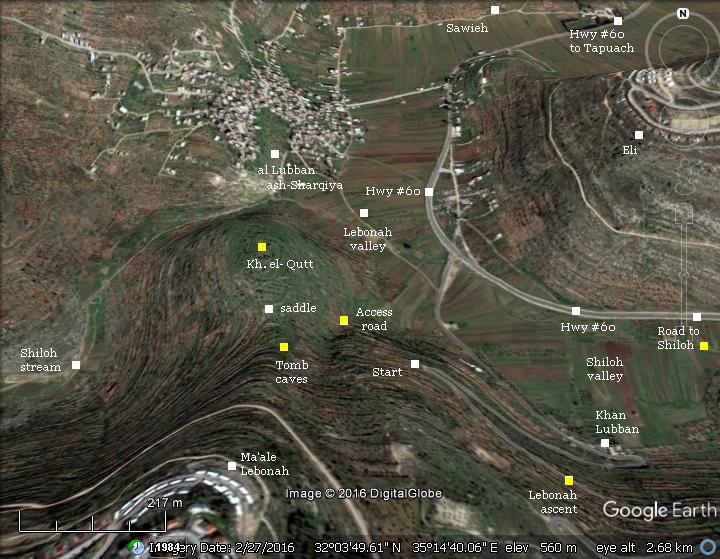
History:
- Biblical times – Judges period (Iron Age I)
According to the ceramic study of the site, the settlement on the hill was first inhabited during the Iron Age I period, although at that period the ceramics distribution is yet low.
A Biblical map is shown here. An ancient route (indicated by a dashed line) from Samaria and Shechem to Jerusalem, passed on the side of site (“Lebonah”). The site of khirbet el-Qutt is marked by a red marker.
Roads and cities during the Israelite period thru the Hasmonean period, 12th 1st century BC (based on Bible Mapper 3.0)
The Lebonah valley below the site, and the ancient highway from Bethel to Shechem passing near the site, were mentioned in the Bible in accordance with the feast of love (the 15th of the month of Av – the Biblical Valentine’s day). During the feast, unmarried girls went to dance in the vineyards, were young men picked up their wives. This feast was adapted for the tribe of Benjamin after the incident of the concubine of Gibeah (Judges 19-21), allowing them to intermarry with other tribes (Judges 21:19-23):
“Then they said, Behold, there is a feast of the LORD in Shiloh yearly in a place which is on the north side of Bethel, on the east side of the highway that goeth up from Bethel to Shechem, and on the south of Lebonah. Therefore they commanded the children of Benjamin, saying, Go and lie in wait in the vineyards; And see, and, behold, if the daughters of Shiloh come out to dance in dances, then come ye out of the vineyards, and catch you every man his wife of the daughters of Shiloh, and go to the land of Benjamin. And it shall be, when their fathers or their brethren come unto us to complain, that we will say unto them, Be favorable unto them for our sakes: because we reserved not to each man his wife in the war: for ye did not give unto them at this time, that ye should be guilty. And the children of Benjamin did so, and took them wives, according to their number, of them that danced, whom they caught: and they went and returned unto their inheritance, and repaired the cities, and dwelt in them”.
- Iron Age II (10th-8th century BC)
During the Israelite Kingdom the site was inhabited. More than 7% of the ceramic vessels identified in the surveys of the site were dated to the Iron Age II period. The fertile valley below, and the proximity to the major ancient road, made this site an ideal location.
- Persian Period (538 – 332 BC)
After the return of the exiles to Zion, the village was rebuilt during this period, but it is not known whether it was settled by Jews, Samaritans or others.
- Hasmonean (2nd-1st Century BC)
The Maccabees headed the anti-Hellenization rebellion against the Greek Seleucids who controlled the land of Israel during the second half of Hellenistic period.
The major first battle between the Jewish rebels and the organized armies of the Seleucids occurred in 166 BC along the road from Samaria to Jerusalem. Apollonius, head of the Seleucid force in Samaria, moved his troops to quell the mutiny in the area of Gophna – a strategic hill area that commanded the roads from the plains and Samaria to Jerusalem. Although the history books do not specifically point the location of the battle, it may have occurred in the location of the Lebonah ascent, where the heavy Seleucid troops would have been easily ambushed with the advantage of a light strike force over the heavy armies. The Maccabees prevailed, and the armories captured in the battle fueled the continuation of the rebellion (1 Maccabee 3:10-12):
“And Apollonius gathered together the Gentiles, and a numerous and great army from Samaria, to make war against Israel. And Judas understood it, and went forth to meet him: and he overthrew him, and killed him: and many fell down slain, the rest fled away. And he took their spoils, and Judas took the sword of Apollonius, and fought with it all his lifetime”.
This battle was also described in the history book of Josephus Flavius (Ant. 3 7:1): “When Apollonius, the general of the Samaritan forces, heard this, he took his army, and made haste to go against Judas, who met him, and joined battle with him, and beat him, and slew many of his men, and among them Apollonius himself, their general, whose sword being that which he happened then to wear, he seized upon, and kept for himself; but he wounded more than he slew, and took a great deal of prey from the enemy’s camp, and went his way”.
After a series of successful military campaigns they took control of Judea, liberated the land and created an independent Jewish country in 164 BC. The next years the Hasmoneans struggled with the Seleucids, and a kingdom was established in 140 BC by the elder son of the Maccabees, Simon.
The Hasmoneans expanded their territory, and during the reign of John Hyrcanus they captured and destroyed the Samaritan temple and administration center on Mt Gerizim (112/111 BC). The capital Samaria was besieged in 108-107 BC, then captured and demolished.
Following the conquest of Samaria, the region witnessed a massive Jewish settlement activity. During this time the rural village at el-Qutt was transformed to a large fortified Jewish village.
Coin of John Hyrcanus
The independent Jewish Kingdom continued until the Roman conquest of Pompey the Great in 63 BC.
- Roman period (1st century BC – 4th century AD)
The Hellenistic, Early and Middle Roman periods were the major periods that were identified on the site. The visible structures – walls, cisterns, caves – were mostly from the Hellenistic and Roman periods, with more than a third of the pottery vessels identified in the three surveys. The high point in this area, as witnessed also in nearby sites, was the Early Roman period – towards the end of the second temple period.
Roman road: A major Roman road passed at the foothills of the village, connecting Shechem and Jerusalem. The Peutinger Map (Tabula Peutingeriana), which a section of it is shown here, is a medieval map which was based on a 4th century Roman military road map. The map shows the major roads, with indication of the cities, and geographic highlights (lakes, rivers, mountains, seas). Along the links are stations and distance in Roman miles (about 1.5KM per mile). The map is drawn with west upwards.
In the center of this section is the area of Samaria. The location of el Qutt is marked (by Biblewalks) as a red square. Gofna (10km south of el-Qutt) is marked at a “T”, connecting right to Shechem (“Neapolis”, XX miles from Gofna), left to Jerusalem (XVI miles from Gofna), and west to Lydda (“Luddis”).
p/o Peutinger map of Roman roads; site is marked
There are evidences that the site was occupied by Jewish settlers between the revolts against the Romans. Ritual miqva’ot, ossuaries and hiding complexes were found on the site that were dated to the Bar-Kokhba revolt. The site was identified by Z. Safari as Kfar Lakitia, one of the three Roman garrisons where the Roman Emperor Hadrian stationed forces at the end of the Bar-Kokhba revolt (132-136 AD). The other two locations, according to the Talmudic literature (Eichah Rabbah 1:45), were Beth El in Judea and Hamata (Emmaus). All three locations are located near the main Roman roads to Jerusalem, and the purpose of these units were to corner and seal off the escape routes of the rebels.
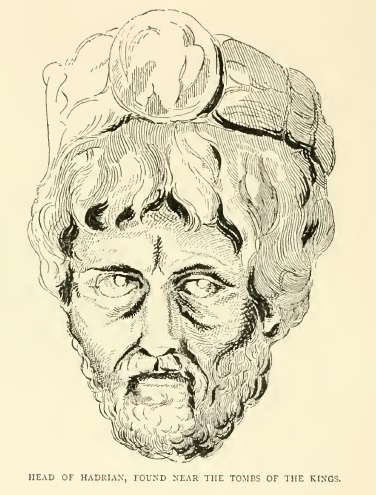
Head of Hadrian, found in the tombs of the Kings (PEF Jerusalem P. 406)
-
Byzantine period (4th – 7th century AD)
During this period the settlement concentrated on the hill top and the eastern slopes. The Byzantine sherds collected on the site totaled more that a quarter of the dated pottery vessels. However, the hewn tombs and cisterns predate the Byzantine period, implying that the settlement during this period was concentrated only in the center of the settlement. It is possible that a monastery was constructed on the hill top.
-
Early Muslim period (7th-13th century AD)
Following the Arab conquest, the settlement on the hill continued for some time. The few pottery vessels were dated to the periods of the caliphates of Ummayad (661-750 AD) and Abbasid (750-1258 AD).
-
Survey of Western Palestine
Conder and Kitchener of the Palestine Exploration Fund (PEF) surveyed the area during the Survey of Western Palestine (SWP) in 1873-75.
They did not identify the historical significance of the site, which is marked here (by BW) as a yellow marker south of el Lubban.
Part of map Sheets 14 of Survey of Western Palestine, by Conder and Kitchener, 1872-1877.
(Published 1880, reprinted by LifeintheHolyLand.com)
Notice the double dashed line passing near the site. It was the path of the ancient route (“Way of the Patriarchs”), that runs along the length of the central watershed. This section, between es-Sawieh and Sunjil, was (and still is) the path of the main road from Shechem and Jerusalem. The only difference is that the ancient road towards the south climbed up the ascent of Lebonah, passing near Khan Lubban on the way to Sunjil, rather than the modern road (#60) which continues east towards Shiloh. So a fortress on a high defendable hill adjacent to the ancient road was an important military asset.
- Modern Period
The site was surveyed by teams headed by Z. Kallai (in the 1960s), I. Finkelstein (1980s), E. Maharian (1990s), B. Zissu (2001), E. Klein (2009), and D. Raviv, B. Har-Even and A. Tavger in 2014.
Khirbet el-Qutt is open to the public and easily accessed from the Lebonah ascent road. Since there are hostile Arab villages in the area, it is advised to tour the place by groups, armed, and coordinated with the authorities.
Photos
Visit to the site was made possible and guided by the archaeologist Dr. Dvir Raviv, and we thank him for this.
(a) Aerial Photos
This aerial view shows the eastern side of the hill. The ruins cover an area of 35 dunams, and cover the summit and the southern and eastern foothills.
In the background is the Arab village of Lubban ash-Sharkiya, which is perched on a terrace on the hill north of the site. The white color of the hill gave the name of the village – Lubban (“milk-white”). On the right is the valley of Lebonah and Highway #60 (north-south intercity highway from Nazareth to Beersheba) on the far right side.
Click on the photos to view in higher resolution…
The next drone view was captured from the west side. The hill of Khirbet el-Qutt is connected through a saddle to the higher hill range where the Ma’ale Lebonah (“Lebonah ascent”) community is located on its summit.
Highway #60 to Shiloh is seen on the left side, crossing the Lebonah valley. In the middle of the far background is the serpentile Lebonah ascent.
![]() The following YouTube video shows a flight of a drone over the site.
The following YouTube video shows a flight of a drone over the site.
(b) South
The community of Ma’ale Lebonah (“Lebonah ascent”) is located to the south of Khirbet el-Qutt. We walked from the road entering to the community, along a path that passes along the ancient burial caves, cisterns and and ritual baths (miqva’ot).
One miqveh was found near the trees seen here in the center of the photo. An ancient cistern, located near the entrance to the path, was turned into a memorial place (“Ariela’s cistern”).
From the path is a view of the el-Qutt hill, and the village of Lubban ash-Sharkiya in the right background.
Another miqveh (number #24 on Dvir Raviv’s map) is located farther down the path, about 450m south east of khirbet el-Qutt. Several steps lead down into the cave of this ritual bath.
(c) Tombs
On the south and southeast of the hill are more than 18 rock hewn tombs.
This was the necropolis of the ancient village. Most of the tombs are dated to the Second temple period.
This monumental tomb is typical of Second Temple Jewish tombs, such as the tomb of Bnei Hezir in Jerusalem.
The facade of the tomb is a classical architecture design called “dystillos-in-antis”, meaning: two pillars between two pilasters. This design was used by Jews in the late Hellenistic and Early Roman period for structures and hewn tombs.
Dystillos-in-antis type facade
Dvir Raviv, who surveyed the Necropolis and published a map of the site, was very excited to find this tomb, which did not appear in his article on Khirbet el-Qutt.
Inside, on the southern inner wall of the antechamber, is a small narrow and low entrance that enters into a main burial chamber. Dvir crawls into it to explore the burial place.
(d) Road to the village
The ancient road to the village climbs up from the valley along the north side of the continuation of the hill range, in a south west direction. It then turns north, as seen in this view.
Along the road are several burial caves (#21, #22, #23 in Raviv’s map).
The road reaches the site at its south side, where the flat area of the saddle connects the hill to the southern hill range. Near the road are 2 cisterns (marked #5 and #6 on Raviv’s map).
In this photo Dvir and Tuvia walk towards the southern foothills, among the olive trees.
(e) Southern foothills
The aerial view shows the southern foothills. The access road to the village climbs up this side of the hill, where the height difference to the saddle is less than all other sides of the hill.
The hillside is terraced, with olive trees planted between the walls.
The height difference from the flat saddle to the summit is only ~40m, and is divided by 6-7 rings of walls that surround the hill.
Along the southern foothill are three miqva’ot (numbered #1 and #3 on Raviv’s map).
(f) Eastern side
The aerial view shows the eastern side of the hill. The height difference from the summit to the valley is 120m, a drop of 40% slope within a distance of 300m.
A closer view of the eastern side:
- Farming Terraces
The hill was used for farming after the ancient village was ruined. But how can you farm a 40% slope terrain? The answer is using terraces.
The slopes of the hill are cut into series of successively receding flat platforms, with walls separating the stepped surfaces. This allowed to conveniently farm each stepped platforms, with each level connecting in one or more places to its neighboring steps.
-
Monumental building
Remains of a monumental building can be seen on the eastern side, close to the summit. The structure’s size is 30m x 30m, and is constructed by large (1m by 0.6m) dressed stones.
On the west side of the structure, seen in the following photo, are remains of a vault. This structure appears to be a Late Roman or Byzantine structure. It may have served as a fortress, or was part of a monastery.
- Hiding complex:
On the south eastern side is an underground hiding complex. It was initially an underground wine cellar, but later was converted to a hiding place.
Entry to the complex was through a round opening, 60 cm wide, which leads to a bell shaped cistern. Narrow openings in that cistern connect to three chambers. The pottery sherds identified in the hiding complex are dated to the end of the 1st century AD, and therefore it is probable that the hiding complex was hewn during the Bar Kokhba revolt.
(f) Western side
This aerial photo shows the western side of the site, and the connected hill range on its southern side.
A closer view of the western side of the hill:
The next photo shows a view from the summit towards the west. This is the valley of the Shiloh stream, which flows towards the sea.
(f) Summit
An aerial view of the summit is seen here from the east side.
On the summit are remains of structures.
Some water cisterns are located on the summit.
(f) Lebonah Ascent
A great panoramic view of the Lebonah ascent can be seen from the roof of a private house at the upper side of the road. In this view are the many loops of the serpentile road, rising up 180m above the Lebonah valley.
A closer view of the ascent is below. The ancient inn, Khan Lebonah, is located on the lower side of the road. Khirbet el-Qutt is seen in the center, and behind it on the right side is the Arab village of Lubban ash-Sharkiya.
A Panoramic view, as seen from the top of the ascent, is shown in the following picture. If you press on it, a panoramic viewer will upload.
Etymology (behind the name):
* Names of the place and vicinity:
- el Qutt – Arabic name (meaning?)
- el Lubban – Arabic: the milk (white). From the white cliff beyond the village (PEF explanation).
- Al Lubban ash-Sharqia – the ‘Eastern’ Lubban. Another village, Lubban al Gharbia (the ‘western’) is located in the western Samaria near the Rantis border crossing.
- Lebonah – Hebrew: white. Judges 21:19: “…on the east side of the highway that goeth up from Bethel to Shechem, and on the south of Lebonah”.
Links and References:
* External:
- Dvir Raviv’s academic papers including Tibneh’s cemetery
- Khirbet el-Qutt A Fortified Jewish Village in Southern Samaria from the Second Temple Period and the Bar Kokhba Revolt – D. Raviv, B. Har-Even, A. Tavger
- Eichah Rabbah – Midrash (for Hadrian’s garrisons; Hebrew)
- The Bar Kokhba revolt – A. Oppenheimer (pdf, Immanuel 1982)
* Biblewalks sites:
- Drone Aerial views – collection of Biblical sites from the air
- Shiloh – religious capital of Israel after the conquest of Canaan
- Hiding Complexes info page
BibleWalks.com – exploring Ephraim
Tibneh <<<—previous site—<<<All Sites>>>—next Samaria site—>>> Horvat Aner
![]()
This page was last updated on Mar 21, 2024 (remove pano)
Sponsored links:
